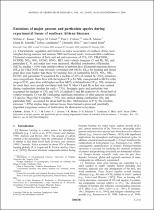 ResearchSpace
ResearchSpace
Emissions of major gaseous and particulate species during experimental burns of southern African biomass
JavaScript is disabled for your browser. Some features of this site may not work without it.
- ResearchSpace
- →
- Research Publications/Outputs
- →
- Journal Articles
- →
- View Item
| dc.contributor.author |
Keene, WC

|
|
| dc.contributor.author |
Lobert, RM

|
|
| dc.contributor.author |
Crutzen, PJ

|
|
| dc.contributor.author |
Maben, JR

|
|
| dc.contributor.author |
Scharffe, DH

|
|
| dc.contributor.author |
Landmann, T

|
|
| dc.contributor.author |
Hely, C

|
|
| dc.contributor.author |
Brain, C

|
|
| dc.date.accessioned | 2007-06-29T09:43:14Z | |
| dc.date.available | 2007-06-29T09:43:14Z | |
| dc.date.issued | 2006-02 | |
| dc.identifier.citation | Keene, WC, et al. 2006. Emissions of major gaseous and particulate species during experimental burns of southern African biomass. Journal of Geophysical Research - Atmospheres, vol. 111(D4) | en |
| dc.identifier.issn | 0148-0227 | |
| dc.identifier.uri | http://hdl.handle.net/10204/824 | |
| dc.description | Copyright: 2006 American Geophysical Union | en |
| dc.description.abstract | Characteristic vegetation and biofuels in major ecosystems of southern Africa were sampled during summer and autumn 2000 and burned under semicontrolled conditions. Elemental compositions of fuels and ash and emissions of CO2, CO, CH3COOH, HCOOH, NOX, NH3, HONO, HNO3, HCl, total volatile inorganic Cl and Br, SO2 and particulate C, N, and major ions were measured. Modified combustion efficiencies (MCEs, median=0.94) were similar to those of ambient fires. Elemental emissions factors (EFel) for CH3COOH were inversely correlated with MCEs; EF(el)s for heading and mixed grass fires were higher than those for backing fires of comparable MCEs. NOX, NH3, HONO, and particulate N accounted for a median of 22% of emitted N; HNO3 emissions were insignificant. Grass fires with the highest EF(el)s for NH3 corresponded to MCEs in the range of 0.93; grass fires with higher and low MCEs exhibited lower EF(el)s. NH3 emissions for most fuels were poorly correlated with fuel N. Most Cl and Br in fuel was emitted during combustion (median for each=73%). Inorganic gases and particulate ions accounted for medians of 53% and 30% of emitted Cl and Br, respectively. About half of volatile inorganic Cl was HCl indicating significant emissions of other gaseous inorganic Cl species. Most fuel S (median=76%) was emitted during combustion; SO2 and particulate SO42- accounted for about half the flux. Mobilization of P by fire (median emission=82%) implies large nutrient losses from burned regions and potentially important exogenous sources of fertilization for downwind ecosystems. | en |
| dc.language.iso | en | en |
| dc.publisher | American Geophysical Union | en |
| dc.subject | Marine boundary layer | en |
| dc.subject | Savanna fires | en |
| dc.subject | Inorganic bromine | en |
| dc.subject | Reactive chlorine | en |
| dc.subject | Nitrous acid | en |
| dc.subject | Trace gases | en |
| dc.title | Emissions of major gaseous and particulate species during experimental burns of southern African biomass | en |
| dc.type | Article | en |
| dc.identifier.apacitation | Keene, W., Lobert, R., Crutzen, P., Maben, J., Scharffe, D., Landmann, T., ... Brain, C. (2006). Emissions of major gaseous and particulate species during experimental burns of southern African biomass. http://hdl.handle.net/10204/824 | en_ZA |
| dc.identifier.chicagocitation | Keene, WC, RM Lobert, PJ Crutzen, JR Maben, DH Scharffe, T Landmann, C Hely, and C Brain "Emissions of major gaseous and particulate species during experimental burns of southern African biomass." (2006) http://hdl.handle.net/10204/824 | en_ZA |
| dc.identifier.vancouvercitation | Keene W, Lobert R, Crutzen P, Maben J, Scharffe D, Landmann T, et al. Emissions of major gaseous and particulate species during experimental burns of southern African biomass. 2006; http://hdl.handle.net/10204/824. | en_ZA |
| dc.identifier.ris | TY - Article AU - Keene, WC AU - Lobert, RM AU - Crutzen, PJ AU - Maben, JR AU - Scharffe, DH AU - Landmann, T AU - Hely, C AU - Brain, C AB - Characteristic vegetation and biofuels in major ecosystems of southern Africa were sampled during summer and autumn 2000 and burned under semicontrolled conditions. Elemental compositions of fuels and ash and emissions of CO2, CO, CH3COOH, HCOOH, NOX, NH3, HONO, HNO3, HCl, total volatile inorganic Cl and Br, SO2 and particulate C, N, and major ions were measured. Modified combustion efficiencies (MCEs, median=0.94) were similar to those of ambient fires. Elemental emissions factors (EFel) for CH3COOH were inversely correlated with MCEs; EF(el)s for heading and mixed grass fires were higher than those for backing fires of comparable MCEs. NOX, NH3, HONO, and particulate N accounted for a median of 22% of emitted N; HNO3 emissions were insignificant. Grass fires with the highest EF(el)s for NH3 corresponded to MCEs in the range of 0.93; grass fires with higher and low MCEs exhibited lower EF(el)s. NH3 emissions for most fuels were poorly correlated with fuel N. Most Cl and Br in fuel was emitted during combustion (median for each=73%). Inorganic gases and particulate ions accounted for medians of 53% and 30% of emitted Cl and Br, respectively. About half of volatile inorganic Cl was HCl indicating significant emissions of other gaseous inorganic Cl species. Most fuel S (median=76%) was emitted during combustion; SO2 and particulate SO42- accounted for about half the flux. Mobilization of P by fire (median emission=82%) implies large nutrient losses from burned regions and potentially important exogenous sources of fertilization for downwind ecosystems. DA - 2006-02 DB - ResearchSpace DP - CSIR KW - Marine boundary layer KW - Savanna fires KW - Inorganic bromine KW - Reactive chlorine KW - Nitrous acid KW - Trace gases LK - https://researchspace.csir.co.za PY - 2006 SM - 0148-0227 T1 - Emissions of major gaseous and particulate species during experimental burns of southern African biomass TI - Emissions of major gaseous and particulate species during experimental burns of southern African biomass UR - http://hdl.handle.net/10204/824 ER - | en_ZA |





